Examining Key Source Documents for Preparing Business Accounts
VerifiedAdded on 2023/04/21
|8
|1128
|250
Report
AI Summary
This report discusses the crucial role of source documents in preparing business accounts, focusing on cheques, receipts, invoices/bills, and cash memos. Cheques facilitate payments, while receipts serve as evidence of cash transactions. Invoices and bills record credit sales and purchases, and cash memos document cash transactions. The report emphasizes the importance of these documents in accurately tracking sales and purchases, aiding in auditing, and ensuring the integrity of financial records. Accountants rely on these sources to gather information for both cash and credit transactions, which is essential for developing accurate accounts. Desklib offers similar solved assignments and past papers for students.
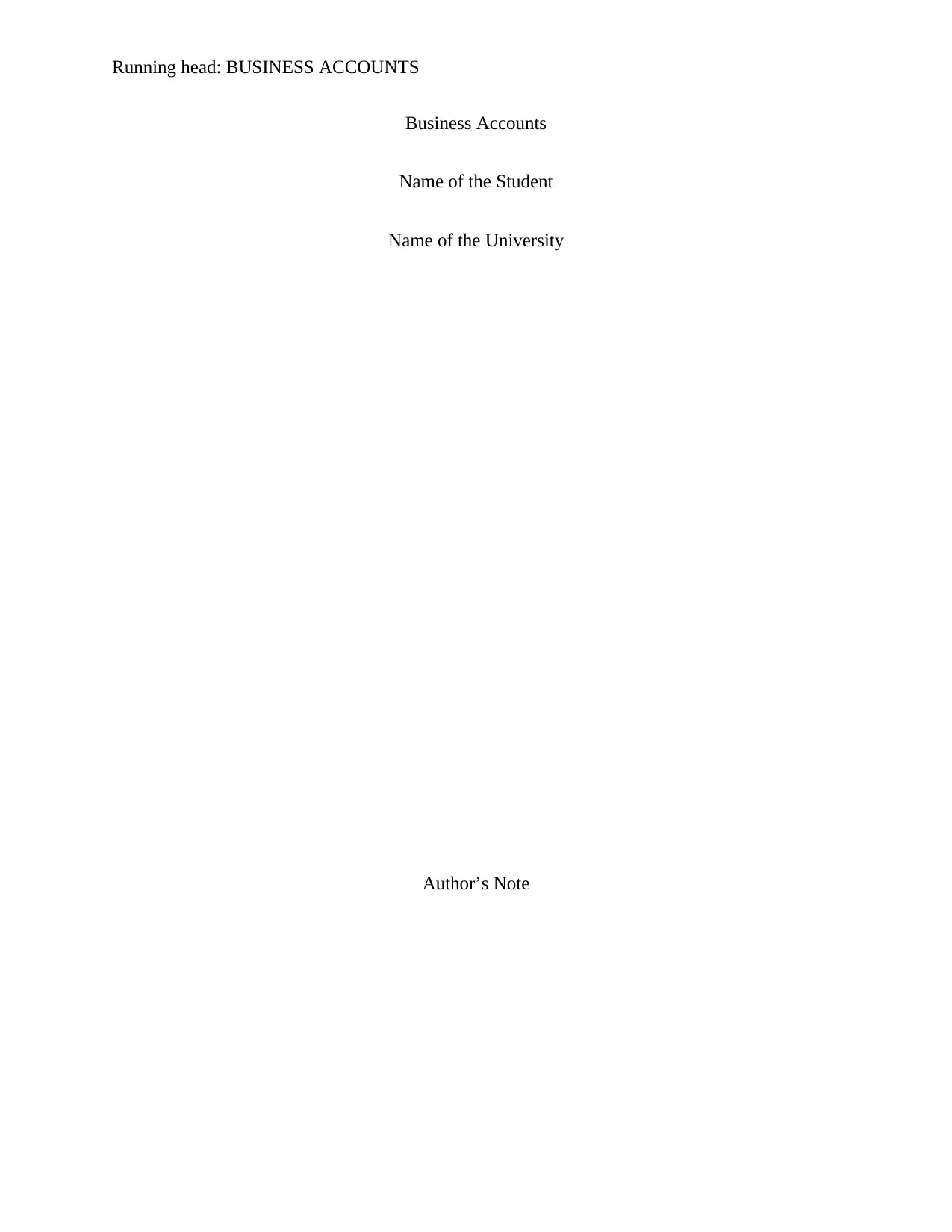
Running head: BUSINESS ACCOUNTS
Business Accounts
Name of the Student
Name of the University
Author’s Note
Business Accounts
Name of the Student
Name of the University
Author’s Note
Paraphrase This Document
Need a fresh take? Get an instant paraphrase of this document with our AI Paraphraser
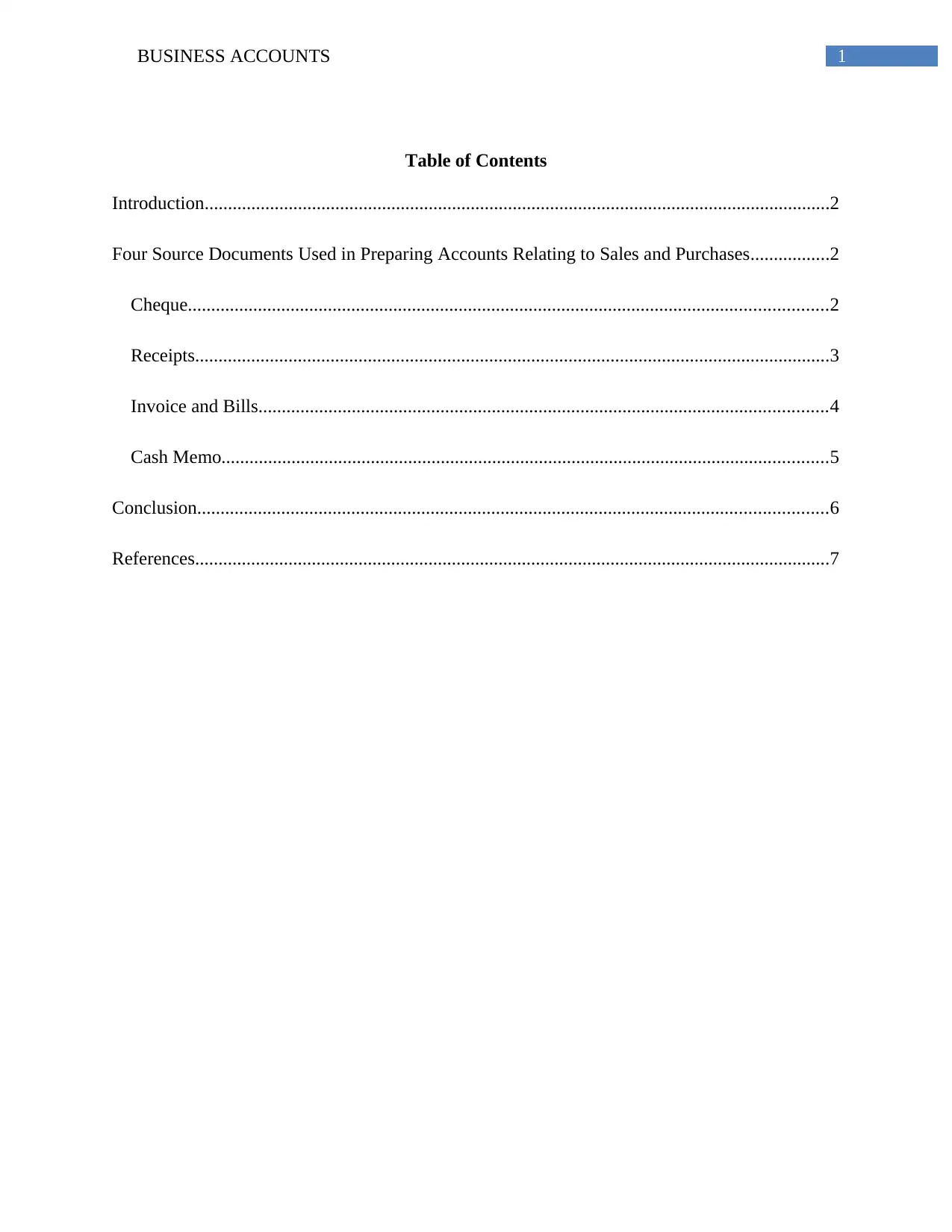
1BUSINESS ACCOUNTS
Table of Contents
Introduction......................................................................................................................................2
Four Source Documents Used in Preparing Accounts Relating to Sales and Purchases.................2
Cheque.........................................................................................................................................2
Receipts........................................................................................................................................3
Invoice and Bills..........................................................................................................................4
Cash Memo..................................................................................................................................5
Conclusion.......................................................................................................................................6
References........................................................................................................................................7
Table of Contents
Introduction......................................................................................................................................2
Four Source Documents Used in Preparing Accounts Relating to Sales and Purchases.................2
Cheque.........................................................................................................................................2
Receipts........................................................................................................................................3
Invoice and Bills..........................................................................................................................4
Cash Memo..................................................................................................................................5
Conclusion.......................................................................................................................................6
References........................................................................................................................................7
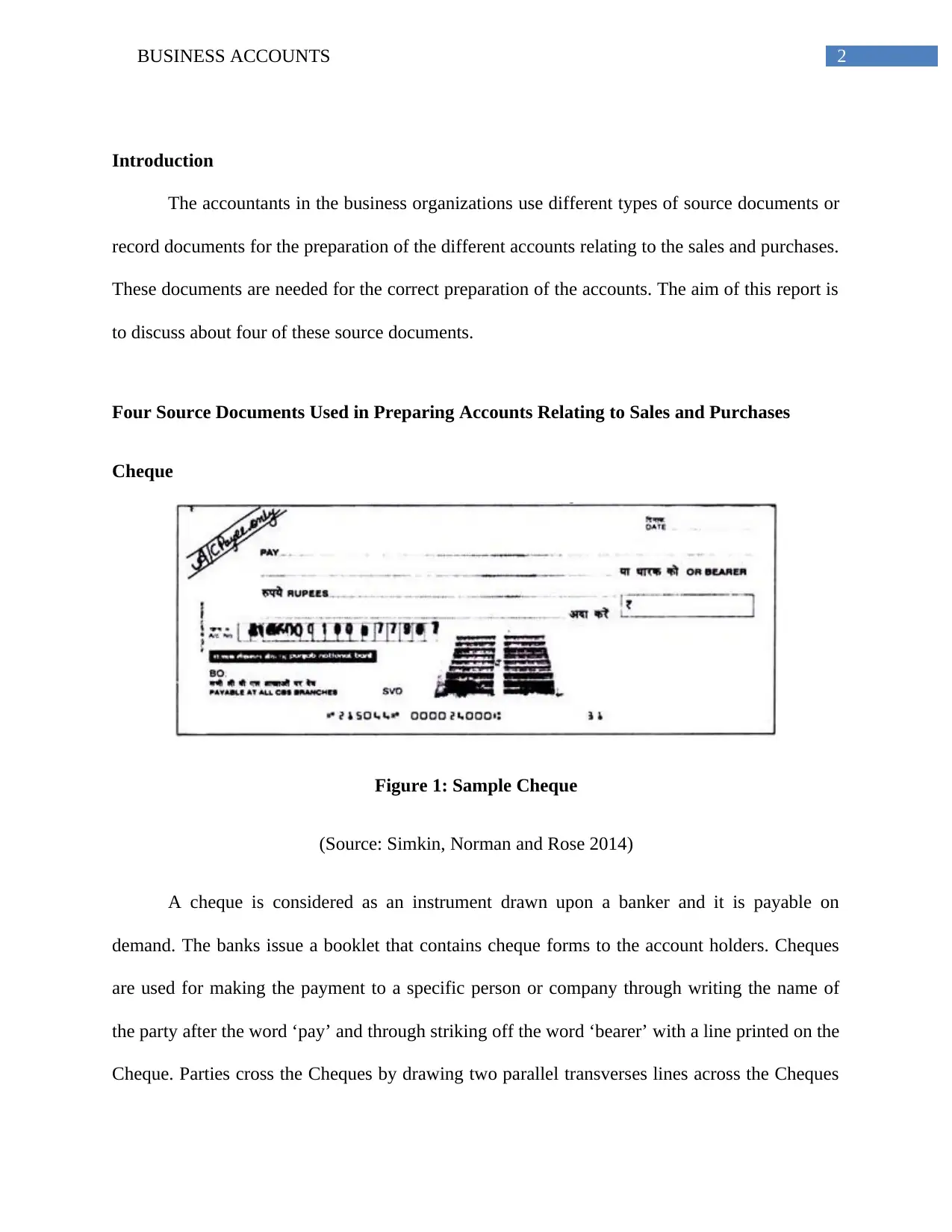
2BUSINESS ACCOUNTS
Introduction
The accountants in the business organizations use different types of source documents or
record documents for the preparation of the different accounts relating to the sales and purchases.
These documents are needed for the correct preparation of the accounts. The aim of this report is
to discuss about four of these source documents.
Four Source Documents Used in Preparing Accounts Relating to Sales and Purchases
Cheque
Figure 1: Sample Cheque
(Source: Simkin, Norman and Rose 2014)
A cheque is considered as an instrument drawn upon a banker and it is payable on
demand. The banks issue a booklet that contains cheque forms to the account holders. Cheques
are used for making the payment to a specific person or company through writing the name of
the party after the word ‘pay’ and through striking off the word ‘bearer’ with a line printed on the
Cheque. Parties cross the Cheques by drawing two parallel transverses lines across the Cheques
Introduction
The accountants in the business organizations use different types of source documents or
record documents for the preparation of the different accounts relating to the sales and purchases.
These documents are needed for the correct preparation of the accounts. The aim of this report is
to discuss about four of these source documents.
Four Source Documents Used in Preparing Accounts Relating to Sales and Purchases
Cheque
Figure 1: Sample Cheque
(Source: Simkin, Norman and Rose 2014)
A cheque is considered as an instrument drawn upon a banker and it is payable on
demand. The banks issue a booklet that contains cheque forms to the account holders. Cheques
are used for making the payment to a specific person or company through writing the name of
the party after the word ‘pay’ and through striking off the word ‘bearer’ with a line printed on the
Cheque. Parties cross the Cheques by drawing two parallel transverses lines across the Cheques
⊘ This is a preview!⊘
Do you want full access?
Subscribe today to unlock all pages.

Trusted by 1+ million students worldwide
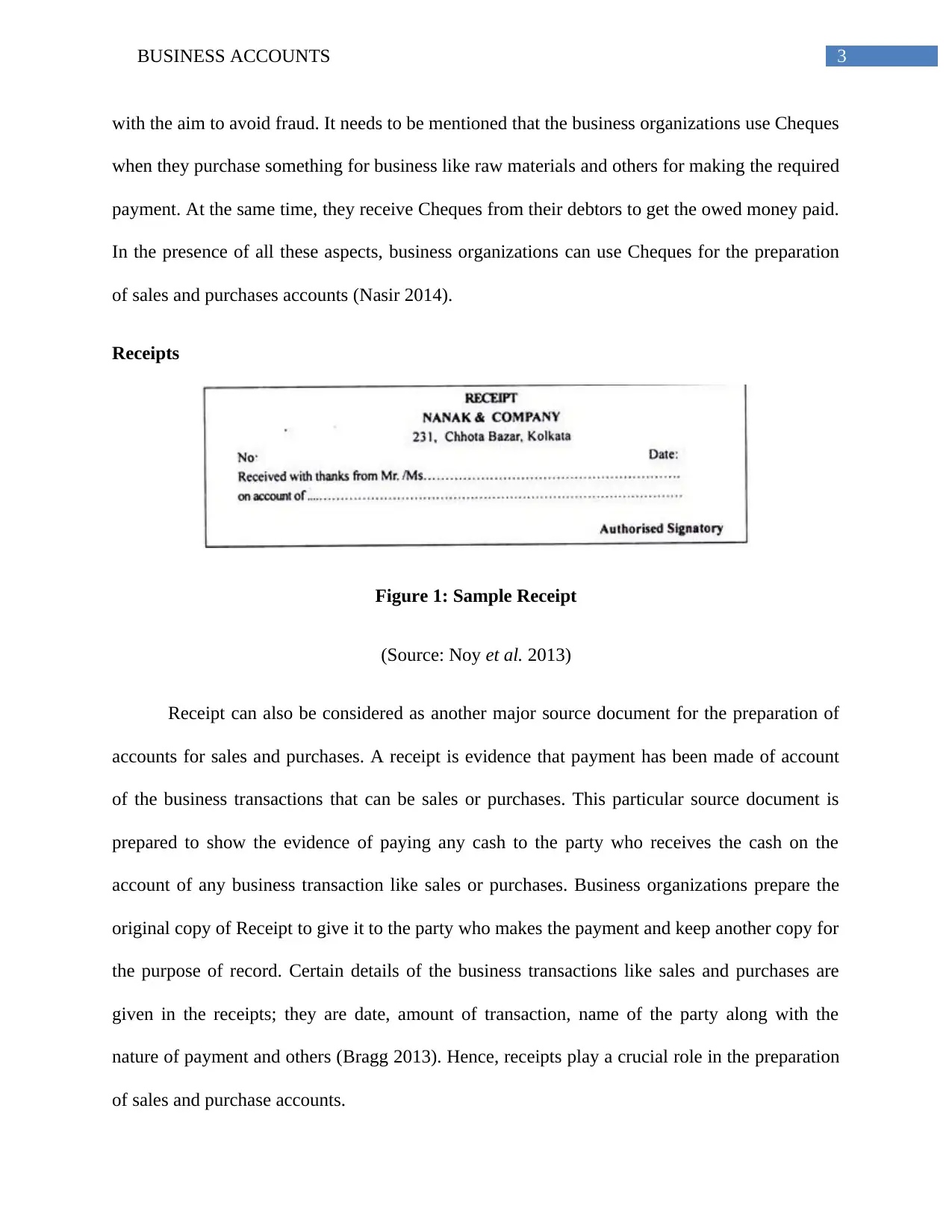
3BUSINESS ACCOUNTS
with the aim to avoid fraud. It needs to be mentioned that the business organizations use Cheques
when they purchase something for business like raw materials and others for making the required
payment. At the same time, they receive Cheques from their debtors to get the owed money paid.
In the presence of all these aspects, business organizations can use Cheques for the preparation
of sales and purchases accounts (Nasir 2014).
Receipts
Figure 1: Sample Receipt
(Source: Noy et al. 2013)
Receipt can also be considered as another major source document for the preparation of
accounts for sales and purchases. A receipt is evidence that payment has been made of account
of the business transactions that can be sales or purchases. This particular source document is
prepared to show the evidence of paying any cash to the party who receives the cash on the
account of any business transaction like sales or purchases. Business organizations prepare the
original copy of Receipt to give it to the party who makes the payment and keep another copy for
the purpose of record. Certain details of the business transactions like sales and purchases are
given in the receipts; they are date, amount of transaction, name of the party along with the
nature of payment and others (Bragg 2013). Hence, receipts play a crucial role in the preparation
of sales and purchase accounts.
with the aim to avoid fraud. It needs to be mentioned that the business organizations use Cheques
when they purchase something for business like raw materials and others for making the required
payment. At the same time, they receive Cheques from their debtors to get the owed money paid.
In the presence of all these aspects, business organizations can use Cheques for the preparation
of sales and purchases accounts (Nasir 2014).
Receipts
Figure 1: Sample Receipt
(Source: Noy et al. 2013)
Receipt can also be considered as another major source document for the preparation of
accounts for sales and purchases. A receipt is evidence that payment has been made of account
of the business transactions that can be sales or purchases. This particular source document is
prepared to show the evidence of paying any cash to the party who receives the cash on the
account of any business transaction like sales or purchases. Business organizations prepare the
original copy of Receipt to give it to the party who makes the payment and keep another copy for
the purpose of record. Certain details of the business transactions like sales and purchases are
given in the receipts; they are date, amount of transaction, name of the party along with the
nature of payment and others (Bragg 2013). Hence, receipts play a crucial role in the preparation
of sales and purchase accounts.
Paraphrase This Document
Need a fresh take? Get an instant paraphrase of this document with our AI Paraphraser
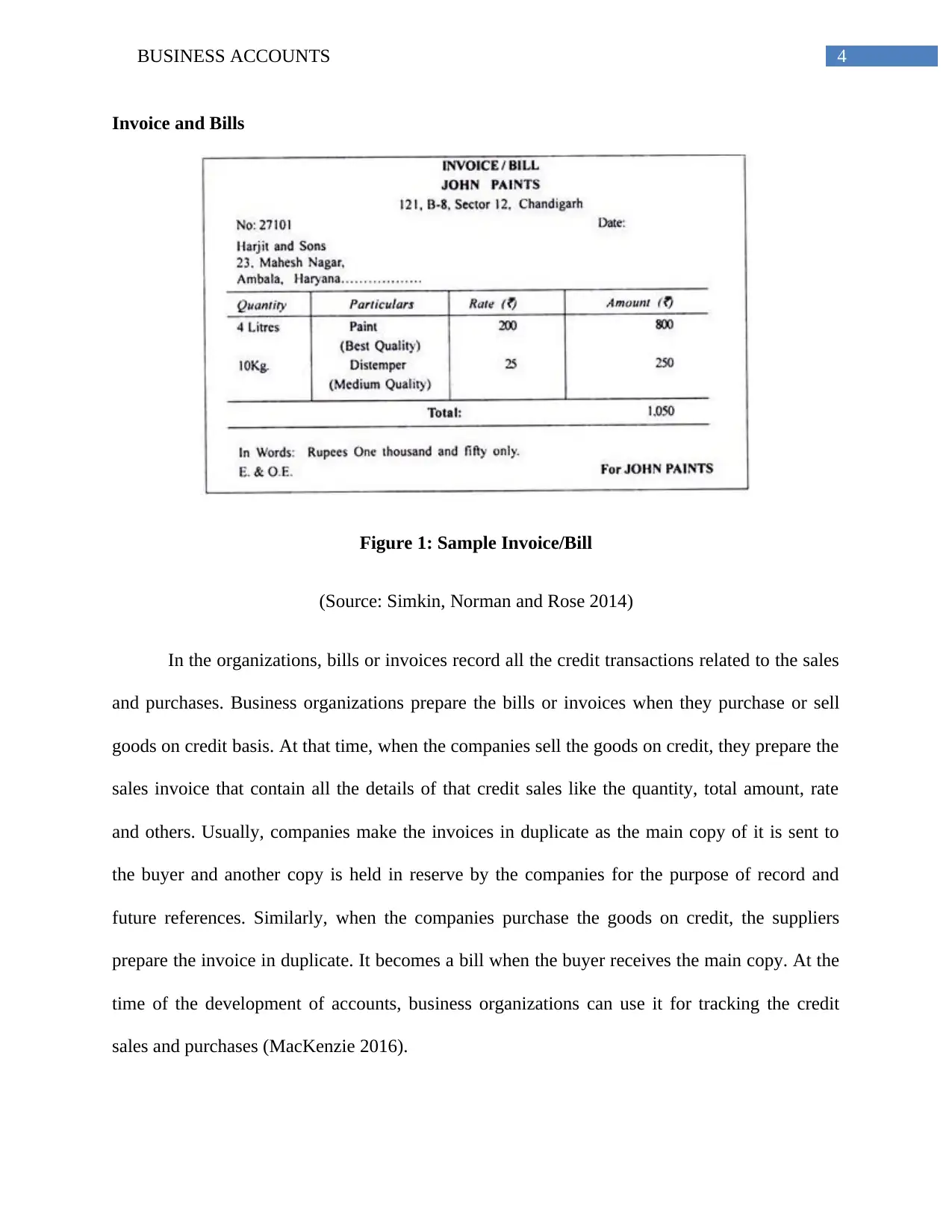
4BUSINESS ACCOUNTS
Invoice and Bills
Figure 1: Sample Invoice/Bill
(Source: Simkin, Norman and Rose 2014)
In the organizations, bills or invoices record all the credit transactions related to the sales
and purchases. Business organizations prepare the bills or invoices when they purchase or sell
goods on credit basis. At that time, when the companies sell the goods on credit, they prepare the
sales invoice that contain all the details of that credit sales like the quantity, total amount, rate
and others. Usually, companies make the invoices in duplicate as the main copy of it is sent to
the buyer and another copy is held in reserve by the companies for the purpose of record and
future references. Similarly, when the companies purchase the goods on credit, the suppliers
prepare the invoice in duplicate. It becomes a bill when the buyer receives the main copy. At the
time of the development of accounts, business organizations can use it for tracking the credit
sales and purchases (MacKenzie 2016).
Invoice and Bills
Figure 1: Sample Invoice/Bill
(Source: Simkin, Norman and Rose 2014)
In the organizations, bills or invoices record all the credit transactions related to the sales
and purchases. Business organizations prepare the bills or invoices when they purchase or sell
goods on credit basis. At that time, when the companies sell the goods on credit, they prepare the
sales invoice that contain all the details of that credit sales like the quantity, total amount, rate
and others. Usually, companies make the invoices in duplicate as the main copy of it is sent to
the buyer and another copy is held in reserve by the companies for the purpose of record and
future references. Similarly, when the companies purchase the goods on credit, the suppliers
prepare the invoice in duplicate. It becomes a bill when the buyer receives the main copy. At the
time of the development of accounts, business organizations can use it for tracking the credit
sales and purchases (MacKenzie 2016).
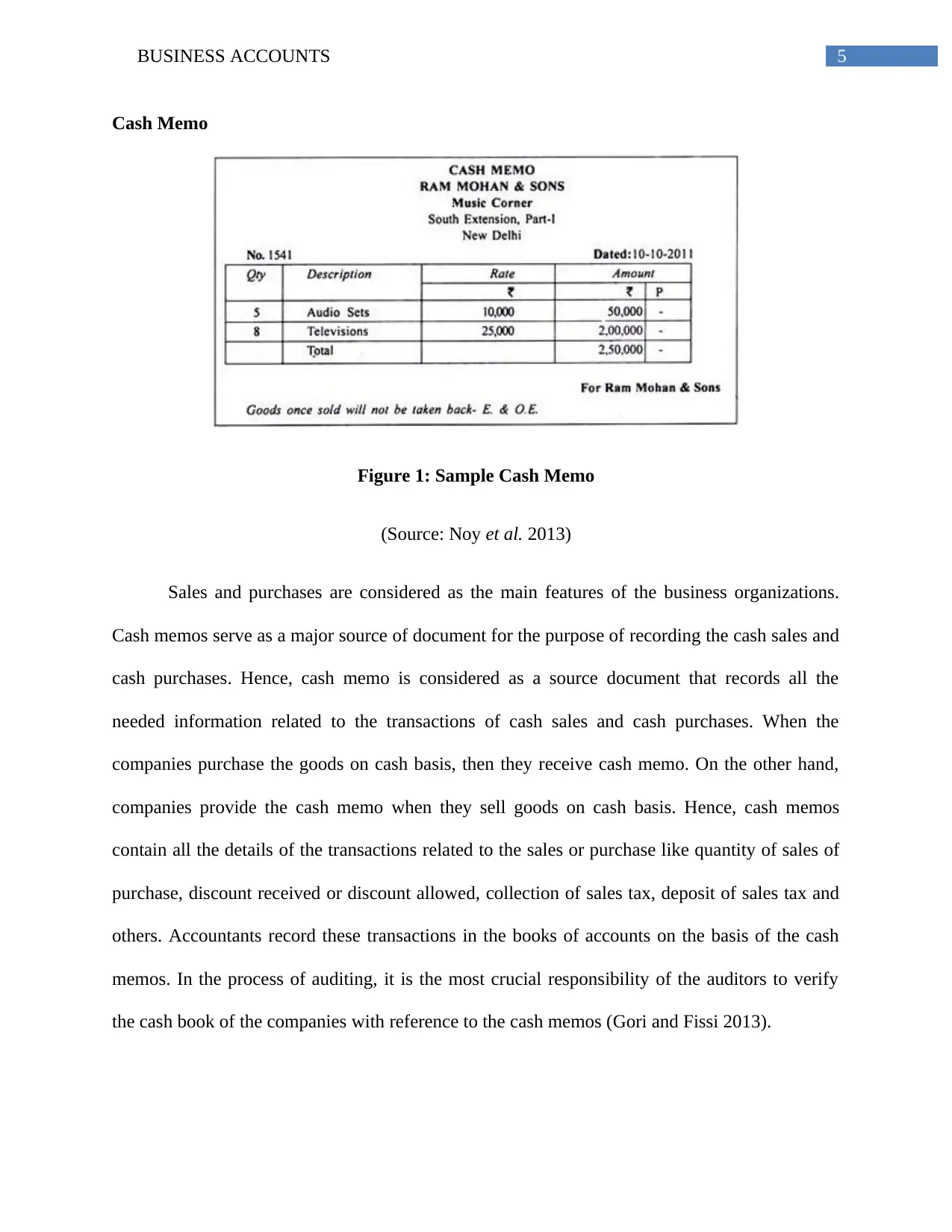
5BUSINESS ACCOUNTS
Cash Memo
Figure 1: Sample Cash Memo
(Source: Noy et al. 2013)
Sales and purchases are considered as the main features of the business organizations.
Cash memos serve as a major source of document for the purpose of recording the cash sales and
cash purchases. Hence, cash memo is considered as a source document that records all the
needed information related to the transactions of cash sales and cash purchases. When the
companies purchase the goods on cash basis, then they receive cash memo. On the other hand,
companies provide the cash memo when they sell goods on cash basis. Hence, cash memos
contain all the details of the transactions related to the sales or purchase like quantity of sales of
purchase, discount received or discount allowed, collection of sales tax, deposit of sales tax and
others. Accountants record these transactions in the books of accounts on the basis of the cash
memos. In the process of auditing, it is the most crucial responsibility of the auditors to verify
the cash book of the companies with reference to the cash memos (Gori and Fissi 2013).
Cash Memo
Figure 1: Sample Cash Memo
(Source: Noy et al. 2013)
Sales and purchases are considered as the main features of the business organizations.
Cash memos serve as a major source of document for the purpose of recording the cash sales and
cash purchases. Hence, cash memo is considered as a source document that records all the
needed information related to the transactions of cash sales and cash purchases. When the
companies purchase the goods on cash basis, then they receive cash memo. On the other hand,
companies provide the cash memo when they sell goods on cash basis. Hence, cash memos
contain all the details of the transactions related to the sales or purchase like quantity of sales of
purchase, discount received or discount allowed, collection of sales tax, deposit of sales tax and
others. Accountants record these transactions in the books of accounts on the basis of the cash
memos. In the process of auditing, it is the most crucial responsibility of the auditors to verify
the cash book of the companies with reference to the cash memos (Gori and Fissi 2013).
⊘ This is a preview!⊘
Do you want full access?
Subscribe today to unlock all pages.

Trusted by 1+ million students worldwide
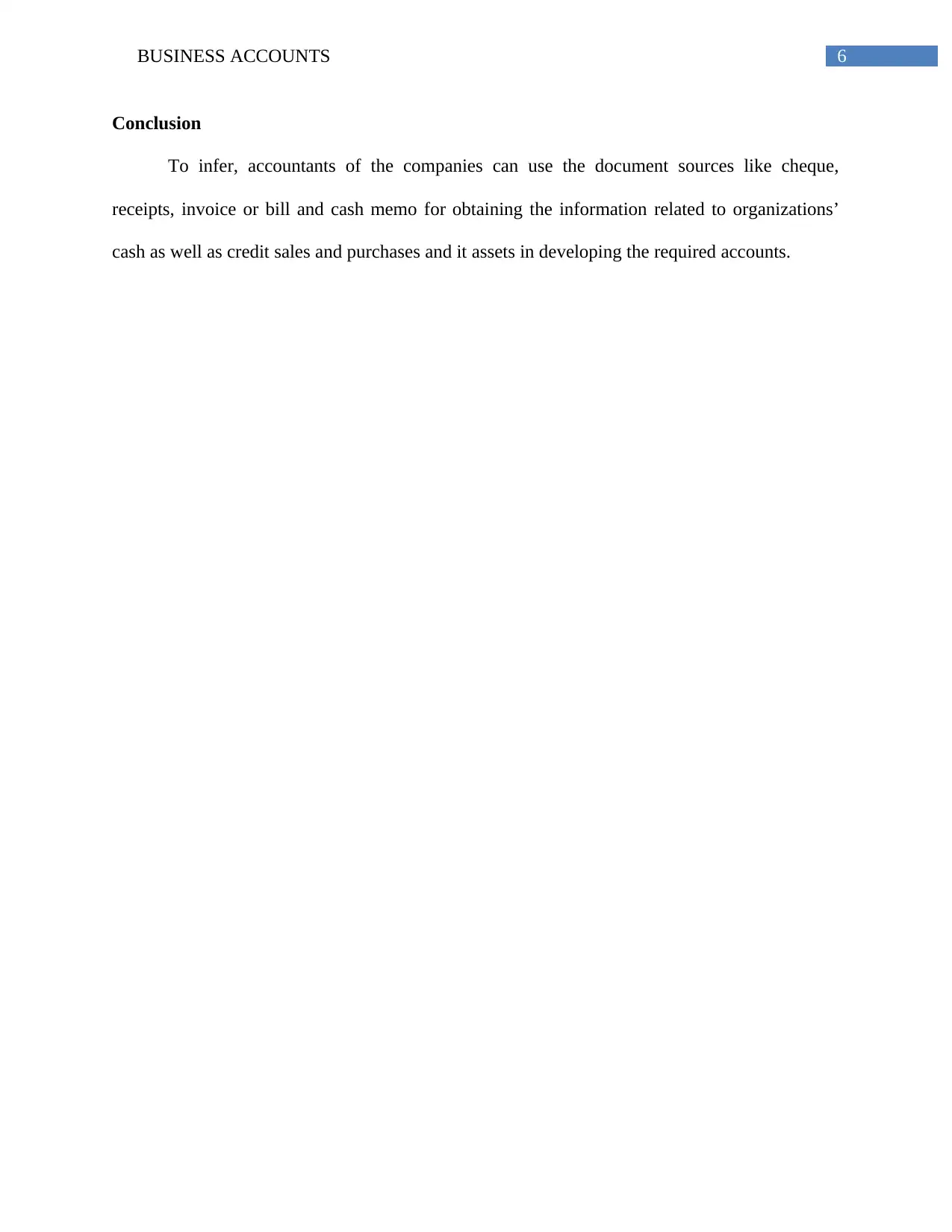
6BUSINESS ACCOUNTS
Conclusion
To infer, accountants of the companies can use the document sources like cheque,
receipts, invoice or bill and cash memo for obtaining the information related to organizations’
cash as well as credit sales and purchases and it assets in developing the required accounts.
Conclusion
To infer, accountants of the companies can use the document sources like cheque,
receipts, invoice or bill and cash memo for obtaining the information related to organizations’
cash as well as credit sales and purchases and it assets in developing the required accounts.
Paraphrase This Document
Need a fresh take? Get an instant paraphrase of this document with our AI Paraphraser
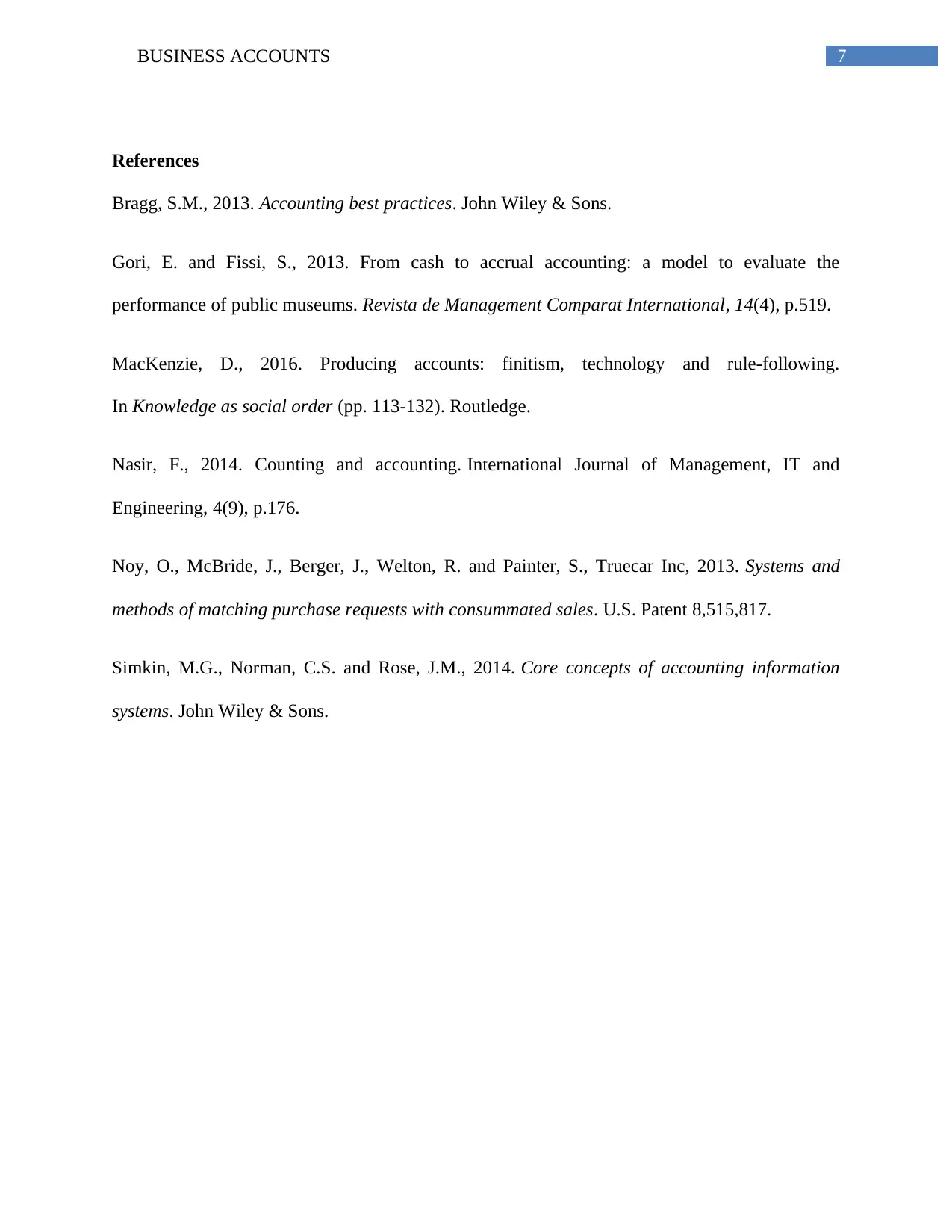
7BUSINESS ACCOUNTS
References
Bragg, S.M., 2013. Accounting best practices. John Wiley & Sons.
Gori, E. and Fissi, S., 2013. From cash to accrual accounting: a model to evaluate the
performance of public museums. Revista de Management Comparat International, 14(4), p.519.
MacKenzie, D., 2016. Producing accounts: finitism, technology and rule-following.
In Knowledge as social order (pp. 113-132). Routledge.
Nasir, F., 2014. Counting and accounting. International Journal of Management, IT and
Engineering, 4(9), p.176.
Noy, O., McBride, J., Berger, J., Welton, R. and Painter, S., Truecar Inc, 2013. Systems and
methods of matching purchase requests with consummated sales. U.S. Patent 8,515,817.
Simkin, M.G., Norman, C.S. and Rose, J.M., 2014. Core concepts of accounting information
systems. John Wiley & Sons.
References
Bragg, S.M., 2013. Accounting best practices. John Wiley & Sons.
Gori, E. and Fissi, S., 2013. From cash to accrual accounting: a model to evaluate the
performance of public museums. Revista de Management Comparat International, 14(4), p.519.
MacKenzie, D., 2016. Producing accounts: finitism, technology and rule-following.
In Knowledge as social order (pp. 113-132). Routledge.
Nasir, F., 2014. Counting and accounting. International Journal of Management, IT and
Engineering, 4(9), p.176.
Noy, O., McBride, J., Berger, J., Welton, R. and Painter, S., Truecar Inc, 2013. Systems and
methods of matching purchase requests with consummated sales. U.S. Patent 8,515,817.
Simkin, M.G., Norman, C.S. and Rose, J.M., 2014. Core concepts of accounting information
systems. John Wiley & Sons.
1 out of 8
Related Documents
Your All-in-One AI-Powered Toolkit for Academic Success.
+13062052269
info@desklib.com
Available 24*7 on WhatsApp / Email
![[object Object]](/_next/static/media/star-bottom.7253800d.svg)
Unlock your academic potential
Copyright © 2020–2025 A2Z Services. All Rights Reserved. Developed and managed by ZUCOL.




